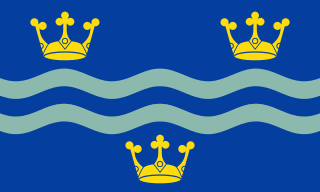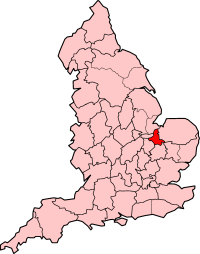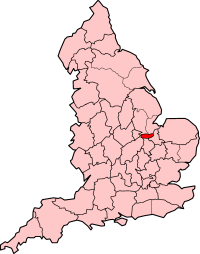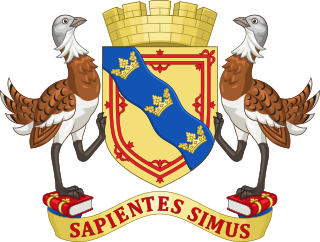
Cambridgeshire is a ceremonial and non-metropolitan county in the East of England government statistical region, and popularly known as one of the three counties of East Anglia. The largest city is Peterborough, followed by the county town of Cambridge. In 1974, modern Cambridgeshire was created through the amalgamation of Cambridgeshire and Isle of Ely with Huntingdon and Peterborough, which including the historic counties of Huntingdonshire and the Soke of Peterborough. A majority of the county is locally governed by Cambridgeshire County Council in combination with the lower tier non-metropolitan district councils of Cambridge, East Cambridgeshire, Fenland, Huntingdonshire, and South Cambridgeshire. Peterborough however is governed as a unitary authority with one council, Peterborough City Council. It is bordered by Lincolnshire to the north, Norfolk to the north-east, Suffolk to the east, Essex and Hertfordshire to the south, and Bedfordshire and Northamptonshire to the west.

The Isle of Ely is a historic region around the city of Ely in Cambridgeshire, England. Between 1889 and 1965, it formed an administrative county.

The City of Peterborough is a unitary authority district with city status in the ceremonial county of Cambridgeshire, England. The area is named after its largest settlement, Peterborough but also covers a wider area of outlying villages and hamlets.

The Soke of Peterborough is a historic area of England associated with the City and Diocese of Peterborough, but considered part of Northamptonshire. The Soke was also described as the Liberty of Peterborough, or Nassaburgh hundred, and comprised, besides Peterborough, about thirty parishes.

Huntingdon and Peterborough was a short-lived administrative and geographical county in East Anglia in the United Kingdom. It existed from 1965 to 1974, when it became part of Cambridgeshire.

Cambridgeshire and Isle of Ely was, from 1965 to 1974, an administrative and geographical county in East Anglia in the United Kingdom. In 1974 it became part of an enlarged Cambridgeshire.

Cambridgeshire Constabulary is the local territorial police force that covers the county of Cambridgeshire and Peterborough unitary authority. It provides law enforcement and security for an area of 1,311 square miles (3,400 km2) and population of 856,000 people, in a predominantly rural county. The force of Cambridgeshire includes the cities of Cambridge, Ely and Peterborough, the market towns of Chatteris, Huntingdon, March, Ramsey, St Ives, St Neots, Whittlesey, and town and Port of Wisbech. Its emblem is a crowned Brunswick star containing the heraldic badge of Cambridgeshire County Council.

Stanground is a residential area of Peterborough in the unparished area of Old Fletton, in the Peterborough district, in the ceremonial county of Cambridgeshire, England. For electoral purposes it comprises Stanground South and Fletton & Stanground wards in North West Cambridgeshire constituency.

This is a list of people who have served as Lord Lieutenant of Cambridgeshire. The title Lord Lieutenant is given to the British monarch's personal representative in the counties of the United Kingdom. Lord Lieutenants are supported by an appointed Vice Lord Lieutenant and Deputy Lieutenants. Since 1715, all Lord Lieutenants have also been Custos Rotulorum of Cambridgeshire.
This is a list of the coats of arms of various county councils in England.

Metropolitan and non-metropolitan counties are one of the four levels of subdivisions of England used for the purposes of local government outside Greater London and the Isles of Scilly. As originally constituted, the metropolitan and non-metropolitan counties each consisted of multiple districts, had a county council and were also the counties for the purposes of Lieutenancies. Later changes in legislation during the 1980s and 1990s have resulted in counties with no county council and 'unitary authority' counties with no districts. Counties for the purposes of Lieutenancies are now defined separately, based on the metropolitan and non-metropolitan counties.
Cambridgeshire County Council is elected every four years using the first past the post system of election. As of 2021 the council consists of 61 council seats, representing 60 electoral divisions. The Conservative Party is currently the largest party bloc on the council.

Peterborough City Council is the local authority for Peterborough in the East of England. It is a unitary authority, having the powers of a non-metropolitan county and district council combined. The City was incorporated as a municipal borough in 1874; from 1888, it fell within the jurisdiction of the Soke of Peterborough county council and from 1965, Huntingdon and Peterborough county council. In 1974, it was replaced by a wholly new non-metropolitan district, broadly corresponding to the Soke, in the new enlarged Cambridgeshire. In 1998, Peterborough became independent of Cambridgeshire as a unitary authority, but the city continues to form part of that county for ceremonial purposes as defined by the Lieutenancies Act 1997.

Cambridgeshire County Council is the county council of Cambridgeshire, England. The council consists of 61 councillors, representing 59 electoral divisions. The council is based at New Shire Hall at Alconbury Weald, near Huntingdon. It is a member of the East of England Local Government Association.

Ely is a cathedral city in the East Cambridgeshire district of Cambridgeshire, England, about 14 miles (23 km) north-northeast of Cambridge and 80 miles (130 km) from London.

The city of Ely formed a local government district in the Isle of Ely and Cambridgeshire from 1850 to 1974. It was administered as a local board district from 1850 to 1894, and as an urban district from 1894 to 1974. Unusually for somewhere which claimed city status, Ely was not a municipal borough.

Cambridgeshire and Isle of Ely County Council was the county council of Cambridgeshire and Isle of Ely in the east of England. It came into its powers on 1 April 1965 and was abolished on 1 April 1974. The county council was based at Shire Hall, Cambridge. It was amalgamated with Huntingdon and Peterborough County Council to form an enlarged Cambridgeshire County Council in 1974.

Huntingdon and Peterborough County Council was the county council of Huntingdon and Peterborough in the east of England. It came into its powers on 1 April 1965 and was abolished on 1 April 1974. The county council was based at Walden House, Huntingdon. It was amalgamated with Cambridgeshire and Isle of Ely County Council to form an enlarged Cambridgeshire County Council in 1974.
The ceremonial county of Cambridgeshire, which includes the unitary authority of Peterborough, has returned 7 MPs to the UK Parliament since 1997.

Fenland Hall is a municipal building on County Road, March, Cambridgeshire, England, which serves as the headquarters of Fenland District Council. The building was originally called "County Hall", and was built in 1908–1909 by Isle of Ely County Council to be its meeting place and offices.


















